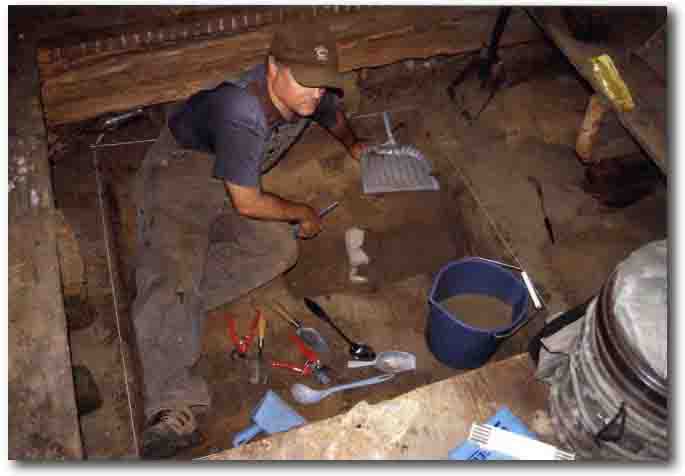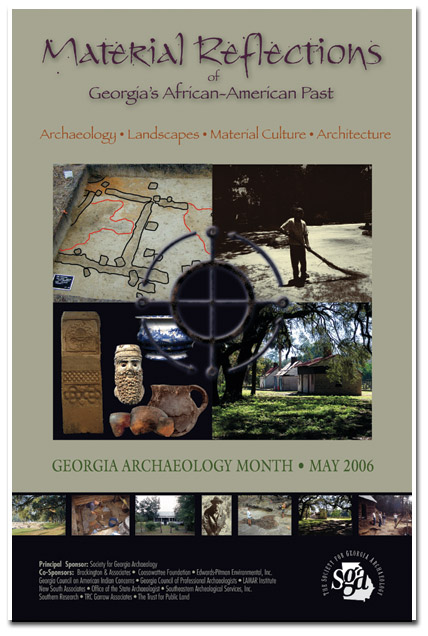 |
|||||
 |
|||||
ARCHAEOLOGY OF SPRINGFIELD
INTRODUCTION TO SPRINGFIELD ARCHAEOLOGY
SPRINGFIELDS’S HISTORIC LANDSCAPE
SPRINGFIELD HOUSE FROM THE RIVERFRONT AUGUSTA ARCHAEOLOGY STUDY
LIFE IN ANTEBELLUM SPRINGFIELD
CHANGE AND DIVERSITY IN POST-WAR SPRINGFIELD
THE NINIVIEN PIPE: A SYMBOL OF HOPE AND FREEDOM
AFRICAN AMERICAN ARCHAEOLOGY IN GEORGIA
|
An archaeologist excavates under the floor of an African American tenant house near Hephzibah as part Georgia DOT's studies for improvements to Highway 25.
The archaeology of African American sites was the subject of Georgia Archaeology month in 2006, and papers from the Society for Georgia Archaeology's Spring Conference are published in the SGA's journal, Early Georgia, in 2007 and 2008. The archaeology of African American sites was the subject of a two-part issue of the Society for Georgia Archaeology's journal, Early Georgia. Click here for the table of content and ordering information.
|
|
AFRICAN AMERICAN ARCHAEOLOGY IN GEORGIA The investigation of Augusta’s Springfield neighborhood is just one example of the archaeological study of African American life in Georgia. Archaeology has a potential to inform us about the lives of people who did not keep records for themselves or who were described by outsiders, often in prejudiced ways. Throughout much of Georgia’s history African Americans were working class people who did not keep journals, write essays, or create written documents that described their everyday lives or their attitudes and beliefs. Consequently, we can piece together bare facts through documents like censuses, slave registers, deeds, and similar sources. Archaeology provides us with another method of understanding aspects of their lives, such as what they ate, how their houses were built, where they lived, and what crafts they produced. It also can suggest how they used material things to build and maintain shared culture and cultural identity, how they expressed it, and how it changed over time and location. The majority of archaeological studies into African American life in Georgia have concentrated on topics related to plantation slaves. Research on plantation labor, origins of slaves, and landscapes have highlighted the African contributions to rice agriculture, which dominated the economy of low country Georgia until the early twentieth century. These studies have also illustrated the effects of African American labor in transforming the low country landscape from tidewater and cypress swamps to productive rice fields. Other topics have focused on the material culture of slaves, particularly on the origins, production, and possible meanings of a type of pottery called “colonoware,” which was made by slaves according to African traditions. Archaeologists have also looked at architecture and the organization of plantations, diet, and social interaction on plantations. Another topic that archaeologists have examined in Georgia concerns rural tenancy. After the Civil War, planters tried to create new labor relationships with former slaves and lower status European-American farmers. This process gave rise to the tenancy system, and archaeologists have sought to study topics like changes in land use and settlement, material aspects of different types of tenancy, and the material culture and lifestyles of tenant farmers. In addition to tenancy, there were African Americans who owned their own farms, but the archaeological study of these kinds of situations has not proceeded very far. The study of African American life in Georgia’s cities and towns has not been very extensive either. The Riverfront Augusta Site represents one of the earliest and most detailed studies of African American urban life in the state. Urban archaeological studies dealing with African American households have looked at topics such as standard of living, diet, and possible indicators of ethnic identity. Yet, there remain many topics to study about African American life in cities, towns, and rural areas. |


